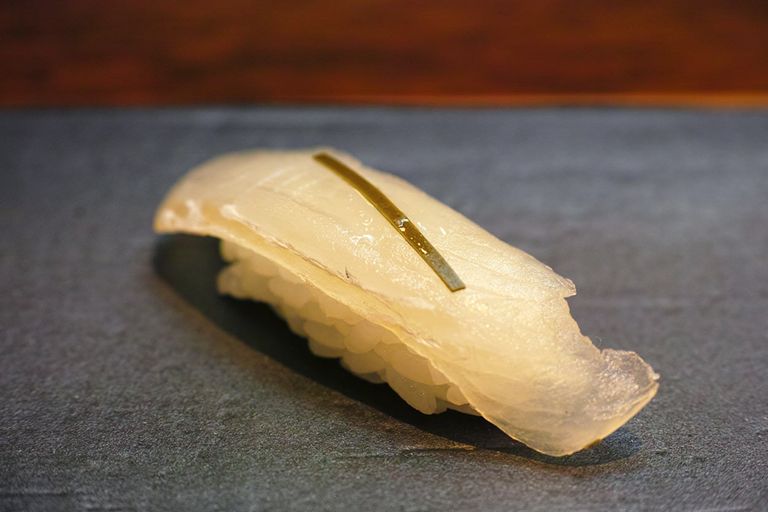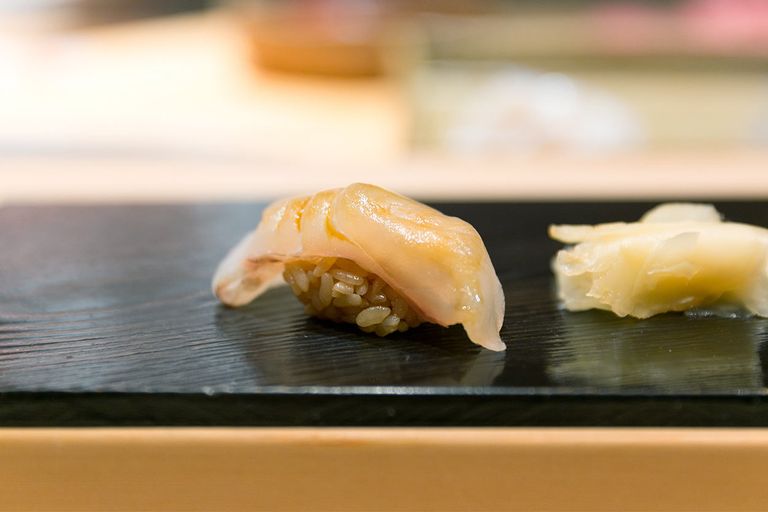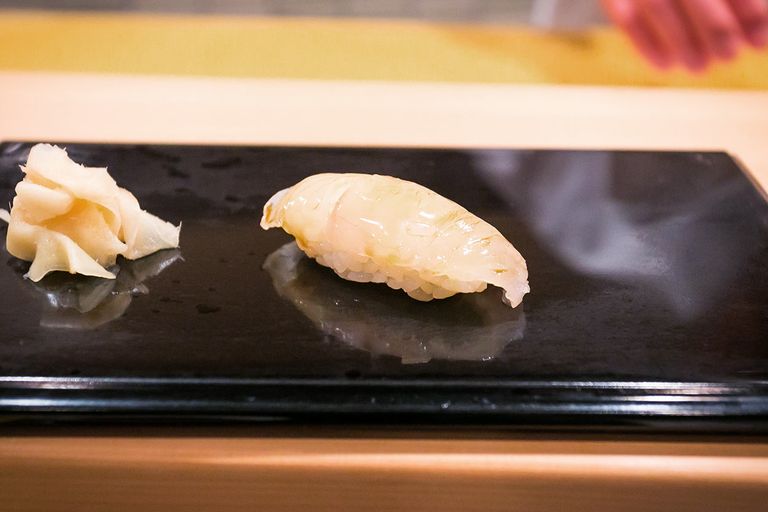Hirame Sushi
A Comprehensive Overview of Bastard Halibut, Large-tooth Flounders in Japanese Sushi Cuisine
ヒラメすし 、 鮃寿司 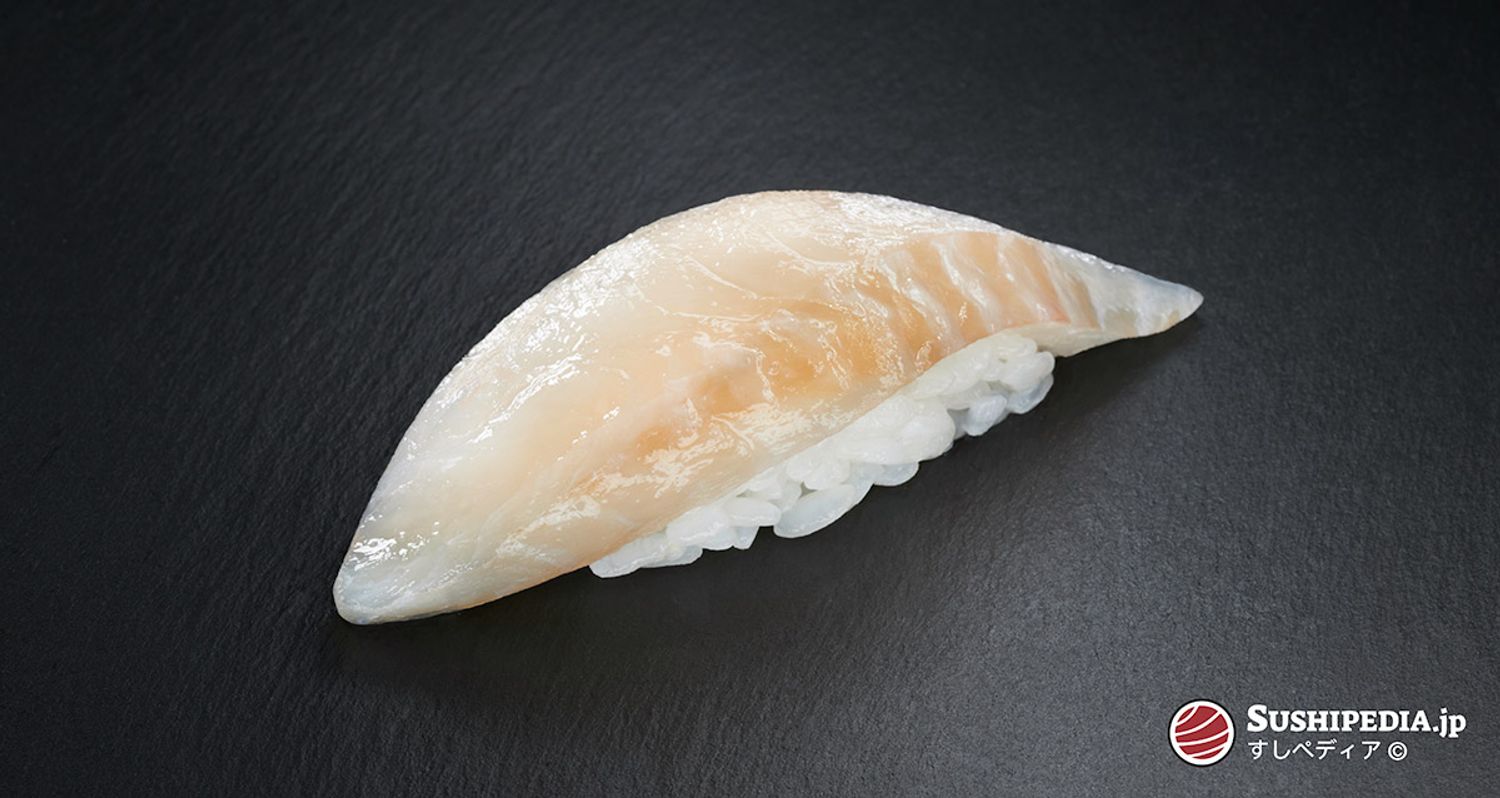
What is Hirame?
Hirame 鮃, the Japanese name for the Japanese flounder (Paralichthys olivaceus), plays a prominent role in Japanese culinary tradition, particularly in the preparation of sushi and sashimi. This species, which is held in high esteem, regularly fetches high market prices due to its quality, especially for wild-caught specimens. The term hirame-ka ヒラメ科, translated as “flounder family”, extends this context to a group of flatfish that includes the Japanese flounder. This classification includes various flounder species that are found in the waters around Japan and other regions and are of considerable importance for both commercial fishing and gastronomy. In other words, the term hirame refers to the entire family of large-tooth flounders (Paralichthyidae), including the hirame itself as a separate species within this group.
Juveniles or hirame that are smaller than 40 cm or weigh less than 2 lbs are referred to as soge ソゲ.[1]
Hirame for Sushi or Sashimi
The firm and very bright meat of hirame is a perfect for sushi and sashimi. The taste of hirame is mild and delicate, its texture is elastic and firm. The meat appears light white to slightly pink. Depending on the part of the fish from which the meat is taken, it may have pink shades, greyish layers or pronounced veins.
The king of whitefish in the cold season is hirame ...
Jiro Ono, Sushi Chef at Sukiyabashi Jiro[2]
In Japanese cuisine, especially in sushi gastronomy, fish are classified according to the appearance of their meat. A distinction is made between red meat (akami), white meat (shiromi) and fish served with a silver skin (hikarimono). Hirame is counted among the white fish.
Very fresh or larger specimens have a tough consistency. By letting it rest or controlled aging (under refrigeration) the meat becomes more tender and aromatic. The maturing time depends on the size of the fish and can last from several hours to three days. The maturing process makes the flesh more tender and gives it an additional aroma. Medium-sized hirame of approx 2 to 2.5 kg, with a slightly rounded and fleshy body, are considered to be very tasty.
Engawa えんがわ【縁側】
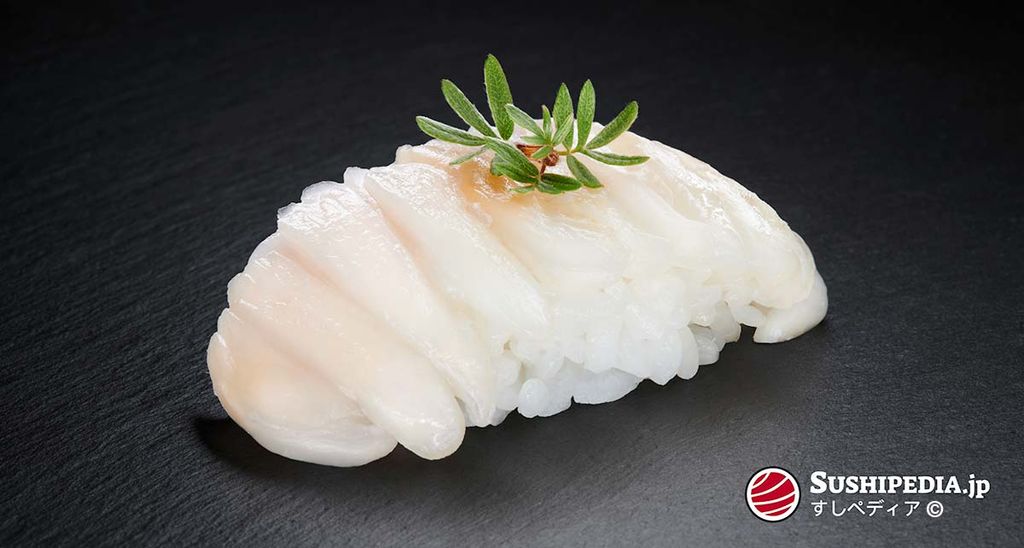
SushiPedia. Engawa Sushi - The Subtle Delicacy of Sushi Cuisine. All rights reserved ©
The meat from the upper and lower fin muscles is known as engawa 縁側 and is particularly appreciated for its crunchy, fatty texture and the intense flavors. Thanks to the high fat content, it tastes deliciously sweet and offers a pleasant aftertaste to the palate. Since engawa comes from the fin sections, the yield of usable meat is accordingly limited and expensive.
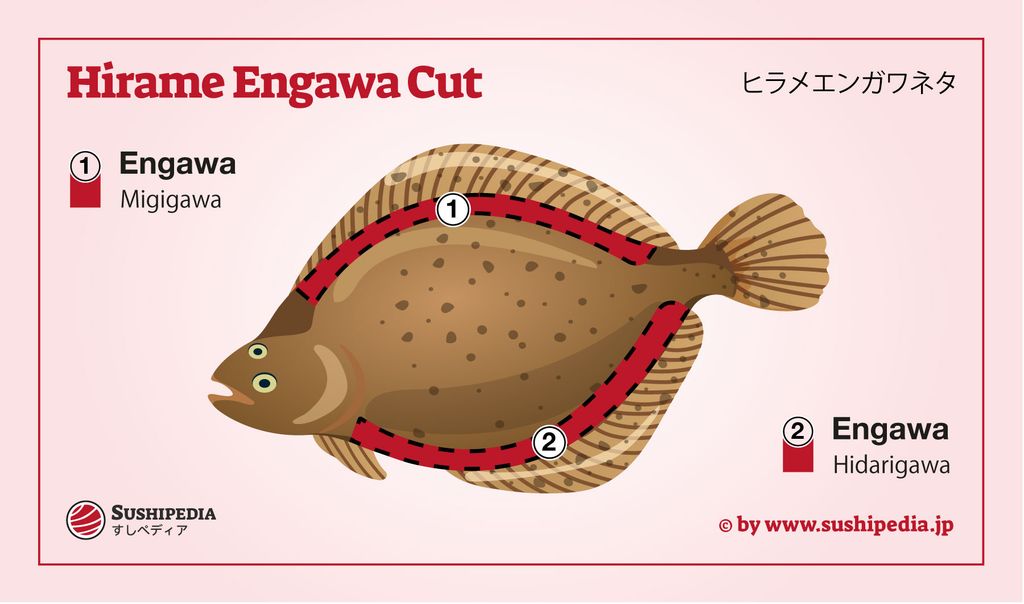
Unknown author. Engawa Hirame Sushi – Distinctive Texture and Flavor Unveiled. All rights reserved ©
The traditional characters in engawa 縁側 are translated as “edge side”. Engawa is frequently described as the wooden balcony found in traditional houses, encapsulating an area that extends along the building's perimeter. It embodies a transitional zone or veranda that skirts the structure's exterior, acting as a bridging space between the inner living areas and the external surroundings. This area is commonly utilized for relaxation, reflection, or as a connecting walkway throughout the building, seamlessly integrating the interior with the exterior in a cohesive manner. With some creativity, one can discern a resemblance between the striped appearance of engawa meat and the parallel lines characteristic of a traditional balcony's underside.
Best Season

SushiPedia. Japanese fishing boat in the fall season. All rights reserved ©
The best season for hirame begins in late autumn and ends in mid-spring. Young hirame, called soge, are already tasty from mid-September to late October and are suitable as an alternative until the beginning of the period when adult hirame gain flavor. During the cold winter months, the fish visibly increase in fat and become more rounded. The higher fat content gives the otherwise extremely light-colored meat an amber tone, this color tone is also considered an indicator of the taste quality. The more amber the flesh of the hirame is, the higher the quality of the taste.
Hirame from industrial breeding is available all year round in a good quality.
Hirame in Japan
In Japanese colloquial language, people who are particularly concerned about the favor of their superior are given the mocking nickname “hirame person” (hirame ningen ヒラメ人間). The expression is a reference to the eyes of the hirame that are constantly looking upwards, similar to a person who is permanently looking only after his superiors and seeking their attention.
A regional specialty is hirame from the city of Hirado 平戸市 in Nagasaki Prefecture. Every year during the fishing season, from mid-January to the end of March, the Hirado Hirame Festival (hirado hirame matsuri 平戸ひらめまつり) is held. During this time, the local restaurants offer wild caught hirame in different variations at special prices.
Important centers of landing wild caught hirame are the prefectures of Hokkaido, Aomori, Nagasaki, Niigata and Ibaraki. The prefectures of Oita, Ehime, Kagoshima, Mie and Nagasaki play a significant role in industrial aquaculture.
The traditional character 鮃 for hirame is composed of the characters 魚 for fish and 平 for flat.
Characteristics & Ecology of Hirame
Hirame are nocturnal fishes, that hide almost completely in the sandy mud during the day. At nightfall they go hunting for crustaceans, small fish, snails, and worms. They also have the ability to adapt their body color to the sea floor and thus camouflage themselves against potential predators.
Their maximum size is 39 inches (ca. 1 meters) with a maximum weight of 19 lbs. Usually they are about 18 to 27 inch (ca. 69 cm) long and weigh between 3 lbs and 6 lbs. Specimens with an approximate length of 11 inch (ca. 28 centimeters) or weigh less than 2 lbs are called soge.
The natural habitat extends from the Sea of Okhotsk, along the coasts of the Sea of Japan, through the South China Sea to the Gulf of Thailand and the coasts of Indonesia. Hirame prefers coastal waters with a depth of 32 to 656 feet (ca. 200 m). Occasionally they can be found in the brackish water of river estuaries.
How they become “flatfish”
A hirame begins its life first as an upright fish. In the first weeks of its life, the metamorphosis starts in which its body shifts in such a way that the eyes and other parts of the trunk move towards the midline of the fish. After about 5 to 6 weeks, the development to a “flatfish” is completed.
Economy of Hirame
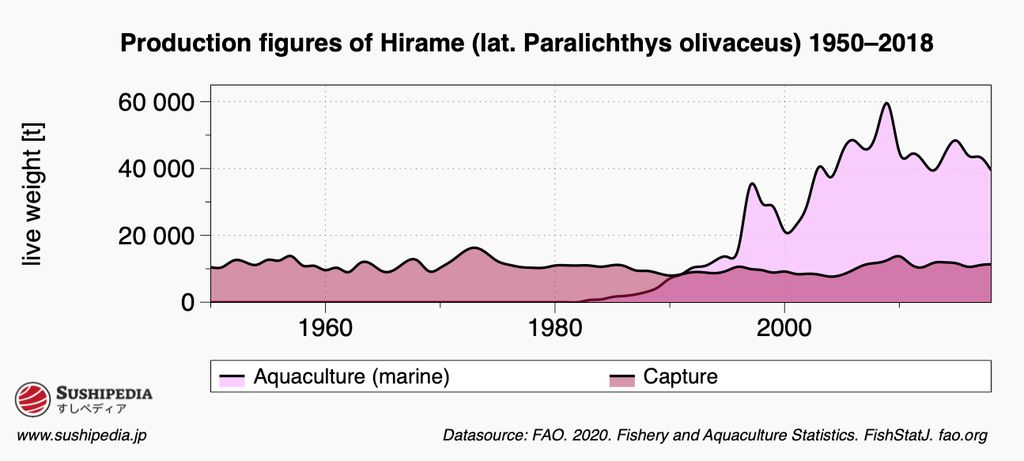
SushiPedia. Production Data of Hirame (Paralichthys olivaceus) from 1950 to 2018. All rights reserved ©
Aquaculture
According to the Food and Agriculture Organization of the United Nations (FAO), Japan and South Korea are the only producers of hirame from both marine fisheries and industrial aquaculture. In both countries, hirame also represents the largest share of flatfish from aquaculture.
In contrast to wild specimens, those from aquaculture often show a false pigmentation on the blind side. Although this pigmentation disorder has also been observed in wild fish, it is by far not as common as in hirame from aquaculture. Thus, with a certain probability, an optical distinction can be made between hirame from aquaculture and a wild one. The reason for the occurrence of these patterns is not yet clear and is the subject of scientific investigations.
Season Calendar for Hirame
The calendar shown does not provide information on fishing times, but marks the periods in which hirame is considered particularly tasty.
Warnings related to Hirame
Video about Hirame Sushi
External video embedded from: youTube.com. Credit Tetrapod Lobo. #Shinkei-zime amazing Hirame #How to fillet #sushi#introducing amazing Japanese ingredients(神経締め).
Species of Hirame
The following species are regarded as authentic hirame. Either historically, according to the area of distribution or according to the common practice in today's gastronomy:
In the following, those species are listed that can be considered as substitutes for authentic species with regard to hirame. This can be based either on their genetic relationship or on their similarity in taste and appearance. The selection is subjective and is not strictly based on Japanese conventions, but also takes into account the practices in the respective areas where the Japanese dishes are prepared. This flexible approach allows for adaptation to local availability and preferences while preserving the core flavor and texture traditionally associated with hirame.
Sources and Further Reading
- [1]平田 剛士. 『脂じゃないんだよ。夏のヒラメは「ソゲ」のほうがうまい (It's not fat. "Soge" is better for summer flounder)』. oretsuri.com, ORETSURI (俺釣)、 2020-05-22. Source retrieved 2/17/2021
- [2]Shinzo Satomi. Sukiyabashi Jiro. Vertical Inc., New York. 2016
- [3]Fish and Fishery Products Hazards and Controls Guidance. U.S. Department of Health and Human Services Food and Drug Administration Center for Food Safety and Applied Nutrition. 2020
- Duk-Young Kang, Soon-Gyu Byun, Jeong-In Myeong, Hyo-Chan Kim, Byoung-Hwa Min. Morphological Analysis of Blind-Side Hypermelanosis of the Starry Flounder, Platichthys stellatus during Early Development.. Development & Reproduction 18 (2). 2014
- Rainer Froese, Pauly Daniel. FishBase. The Leibniz Institute of Marine Sciences at the University of Kiel, FishBase.org, 2019. Source retrieved 12/24/2020
- Bremerhavener Zuchtprojekt für japanische Flundern. Die Welt, Hamburg, 2014-03-27. Source retrieved 12/24/2020
- IUCN Red List of Threatened Species. Version 2023-1
Image Credits
- SushiPedia. Production Data of Hirame (Paralichthys olivaceus) from 1950 to 2018. All rights reserved ©
- SushiPedia. Japanese fishing boat in the fall season. All rights reserved ©
- City Foodsters (Grace Chen, Jason Wang). Hirame, Sushi Tokami, Tokyo, JPN Date Visited: January 29, 2015. flickr.com. Some rights reserved: CC BY 2.0. Changes applied: brightness, contrast, noise, white balance
- Unknown author. Engawa Hirame Sushi – Distinctive Texture and Flavor Unveiled. All rights reserved ©
- SushiPedia. Engawa Sushi - The Subtle Delicacy of Sushi Cuisine. All rights reserved ©
- SushiPedia. Hirame Sushi. All rights reserved ©
- Jun Seita. Hirame Kobu-jime (flatfish), Sushi Asao, Tsukishima, Tokyo SIGMA DP3 Merrill. flickr.com. Some rights reserved: CC BY 2.0. Changes applied: brightness, contrast, noise, white balance
- City Foodsters (Grace Chen, Jason Wang). Hirame (Flat Fish), Sukiyabashi Jiro, Tokyo, JP, Date Visited: December 25, 2013. flickr.com. Some rights reserved: CC BY 2.0. Changes applied: brightness, contrast, noise, white balance
